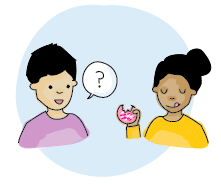By Mollie West Duffy and Kate McCoubrey Judson
Illustrations by Liz Fosslien, fosslien.com
Feedback is a gift--but it's not always easy to give, or to receive. Just last week, the founder of Kate's firm, SYPartners--Keith Yamashita--reached out to her. He had made an off-handed remark about Kate in a team meeting. He meant it humorously. But it didn't feel that way. It felt exclusionary. It felt hurtful. His apology note was brave, heartfelt, and deeply empathetic. He could have left it at that. But instead, he extended an open invitation for feedback--about his own leadership, and the firm itself. It is through understanding and correcting our mistakes, he explained, that we build a better culture.
There are hundreds of articles about how to create a culture of feedback. However, culture isn't something that can be designed itself. Culture is the sum of collective behaviors. You cannot simply introduce one feedback method or tool and expect it to transform workplace culture on its own. Instead, you can design the levers, the structures, the system that will reinforce desired behaviors--and in turn shape culture.
So how do you create consistent behaviors around feedback, and encourage people to trust each other enough to share openly and often? We've collected several examples of tangible ways that companies are doing exactly that.
First, create a framework for giving feedback. Lay the foundation for a culture of feedback by equipping people with a common approach and language around it.
There are dozens of existing models that organizations can adapt and build on. One of the best known is the Situation-Behavior-Impact (SBI) framework. The feedback-giver first describes the situation, then the behavior she observed, and finally how that behavior impacted her and others. Another common model is Stop/Keep/Start, which Netflix uses.
In some organizational cultures, it's best to create a framework from scratch rather than borrow one. As Medium's former Head of Marketing, Gabe Kleinman, explains, "We knew an off-the-shelf [feedback] system wouldn't work, so we designed one ourselves." Medium's MadLib feedback template makes it easy for employees to structure feedback, synthesize patterns, and identify outliers in the responses.
Starter idea: Make a list of what your organization needs most from a feedback framework (e.g., easy to use, promotes candor, makes feedback fun) then find or invent one that fits your needs.
Second, train people on how to give and receive feedback. A brilliant feedback framework is worthless if people don't understand how, when, and why to use it.
At transformation consultancy SYPartners, every employee takes part in Feedback 101, a leader-run workshop on how to give and receive effective, in-the-moment feedback. Participants role-play tough feedback conversations based on real employee experiences--no generic scenarios. SYPartners also offers A Practical Guide to Feedback to help people at any organization learn how to navigate feedback.
Radical Candor--the brainchild of Kim Malone Scott, a former director at Google--provides workshops and tools to empower employees to practice radically candid feedback. Their Candor Gauge app is "your FitBit for feedback," delivering weekly personal assessments to improve feedback-giving skills.
Starter idea: Brainstorm 10-12 approaches to feedback training that could work in your organization (e.g., workshop, coaching, posters), then invite colleagues to weigh in.
Third, prioritize and make regular time for feedback. As one of the simplest, most effective tools for learning and growth, feedback should be a habit--not just an annual task.
Plus, the more often feedback happens, the more normal it feels.
Adobe established informal check-in moments that happen at least once a quarter. Every check-in between managers and employees covers three topics: expectations, feedback, and career development. Managers don't have to follow a script or fill out a report, but they are expected to help their reports improve their performance and correct course if needed. Because feedback is frequent, morale has increased and Adobe employees view feedback as a gift.
At global design company IDEO, teams gather for a feedback session before, during, and after every client project. IDEO calls these sessions "flights," and the goals are to align on project objectives, set team agreements, share individual objectives, and to offer feedback to each other.
Starter idea: Block off an hour every Friday for "Feedback Fridays." Each week, invite a different colleague to swap feedback with you.
Fourth, think about feedback at all moments of the employee journey. Feedback is as valuable for seasoned leaders as it is for interns, and as important for exiting employees as it is for new hires.
Airbnb offers feedback before a person is even hired. Jill Riopelle, head of recruiting, started a practice at Airbnb of offering rejected applicants a chance to get feedback on the phone. This helps applicants stay positive towards Airbnb even if they didn't get a job. The result? More people come back to apply a second time around, but with deeper experience and a better understanding of which roles are right for them.
Starter idea: Sketch an employee journey map, then identify 3-5 new opportunities for feedback conversations.
Fifth, tap into outside sources of feedback. Look to partners, clients, and customers for additional perspective on how you and your team are doing, and where you could improve.
These can be difficult conversations to initiate--particularly in the professional services industry--but they are often immensely valuable. From a client's viewpoint, the best approach that former Coca-Cola SVP John Parker has seen is "when a firm schedules a regular session with us involving a preset agenda of areas to cover and questions to answer... Let's look at the quality, cost and responsiveness of what we've been doing in an organized way. It's shockingly effective."
Starter idea: This week, reach out to one person outside of your company and ask for feedback in a specific area(s), like collaboration or communication.
Use these examples as inspiration for your own organization, but don't create carbon copies. You'll need to tailor your feedback system to your culture to make it stick. For example, if your organization uses OKRs, connect them to your feedback framework. If you have no idea what those three letters stand for, don't use them.
As we approach the end of the year, many organizations are starting year-end reviews. Before these conversations kick off, take a moment to evaluate your current feedback process and culture. Of the five areas listed above, where does your organization need to improve most? How could you start testing ideas for improvement right now? When you imagine your organization at this time next year, how will your feedback culture be different--and what will it have made possible?
About the Authors: Mollie West Duffy is an organizational designer at IDEO in New York, NY. She helps IDEO's clients shape the conditions that influence how employees experience their work. She designed a start-up culture toolkit, and her writing about organizational culture has been published in Fast Company, Quartz, Stanford Social Innovation Review and other digital outlets. You can subscribe to her newsletter or follow her on Twitter.
Kate McCoubrey Judson is a senior strategist a SYPartners in San Francisco, CA, working at the intersection of culture, business, and brand to help leading global companies design their futures. With a background that bridges psychology and design, Kate is deeply curious about the drivers of human behavior change--in the workplace and beyond. Find this visual thinker on Instagram.





